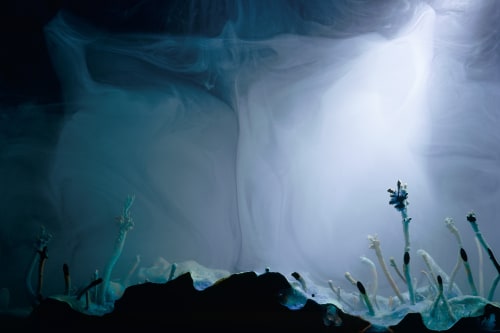Hicham Berrada's work is influenced by his knowledge of natural science. He uses his insight into the complex properties of the materials that make up the realities of life to create fantastic images of potential landscapes. He plays with the laws of nature and reveals to us what is often invisible. Hicham Berrada is best known for his intriguing Présage video works and performances. Here, the artist uses chemical elements to create extraordinary landscapes that generate themselves from the reactions of individual materials with each other and are created under the given circumstances within a certain period of time. They are complete ecosystems that maintain an autonomous aesthetic form.
In “Remains”, the artist’s third solo exhibition at WENTRUP, Berrada now focuses on printed circuit boards and makes them pass a metamorphosis. Built into smartphones, tablets, laptops, and computers, they calculate and store our data and, in this way, manifest human thought. These circuit boards made of silver, copper, platinum, palladium, or gold have become an elementary part of our lives and form the heart of these electronic devices. In the 35-minute video work CPU (2023), a printed circuit board of the same name is decomposed in an electrolytic solution. The gold-coated object almost has the appearance of an artefact. At some point, smoke rises and flows through the liquid. It seems as if the object is burning under water, as if all our knowledge is on fire.
In the group of works titled Cartes Mères (Motherbards), we discover landscapes in blocks of resin. Here Berrada has immersed circuit boards in electronic baths so that the individual metals of which they are composed reorganize themselves. The resulting shapes are reminiscent of crystals, stones, rocks, plants, and trees from a time long ago, or even formations from another world. Fixed forever, like creatures in amber that no longer exist.
Berrada’s new sculptures titled Hygres, and especially created for this exhibition, also look like creatures from another world. With their shiny, partially cracked paint surface, there is something of a cyber beetle about them. These new works are influenced by Max Ernst's Histoire Naturelle (1925), a series of 34 large- format surrealist pencil drawings in frottage technique. The surface structure of an object or material is transferred to a sheet of paper by abrasion with a pencil or coal. For Max Ernst, frottage was a technical device for studying the hallucinatory abilities of the mind. Almost 100 years later, Berrada transfers the frottage technique into the digital age. He scans the shapes and surfaces of various minerals, stones, or plants, and then uses a morphogenesis algorithm that describe the development of animal organisms. The sculptures defy and hybridize earthly laws. Bilateral symmetry, a principle that governs the development of the majority of animal forms. Inert matter rearranges itself in a mirror, around a central axis, as if it were alive. This symmetry allows the chaos to become readable and invites interpretation; the sculptures become the supports of a form of oracle or divination. The Hygres encourage surpassing current earthly limits between organic and inorganic matter. Bearing new paradigms, they are ready to become what the observer wishes to see.
“I don't create forms, but systems that make forms appear. I am sculpting an environment within which landscapes can grow. I don't sculpt landscapes.” says Hicham Berrada, an aspect that is immensely important to the artist. Leaving everything to chance from a certain point onwards. So, it is always a surprise for him how his works end up looking, what emerges from the parameters he defines.
With the exhibition “Remains” Hicham Berrada is expressing the ideas of the remains of our world in a way of futuristic archeology: the dissolving components of the CPU motherboard, the recomposed crystals of Cartes Mères, or the new Hygres – they all look like fossils of the future or creatures from a distant world.
Hicham Berrada (*1986 in Morocco) lives and works in Paris and Roubaix.

